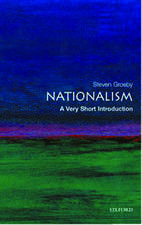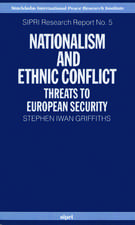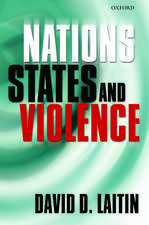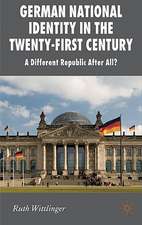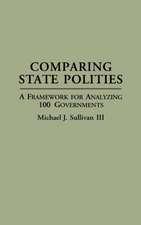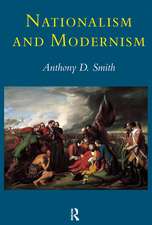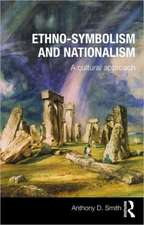Unconventional Warfare in South Asia: Shadow Warriors and Counterinsurgency
Autor Scott Gates, Kaushik Royen Limba Engleză Hardback – 28 ian 2014
| Toate formatele și edițiile | Preț | Express |
|---|---|---|
| Paperback (1) | 469.34 lei 6-8 săpt. | |
| Taylor & Francis – 11 oct 2016 | 469.34 lei 6-8 săpt. | |
| Hardback (1) | 1057.09 lei 6-8 săpt. | |
| Taylor & Francis – 28 ian 2014 | 1057.09 lei 6-8 săpt. |
Preț: 1057.09 lei
Preț vechi: 1289.13 lei
-18% Nou
Puncte Express: 1586
Preț estimativ în valută:
202.29€ • 210.00$ • 168.68£
202.29€ • 210.00$ • 168.68£
Carte tipărită la comandă
Livrare economică 25 martie-08 aprilie
Preluare comenzi: 021 569.72.76
Specificații
ISBN-13: 9781409437062
ISBN-10: 140943706X
Pagini: 218
Dimensiuni: 156 x 234 x 14 mm
Greutate: 0.52 kg
Ediția:New.
Editura: Taylor & Francis
Colecția Routledge
Locul publicării:Oxford, United Kingdom
ISBN-10: 140943706X
Pagini: 218
Dimensiuni: 156 x 234 x 14 mm
Greutate: 0.52 kg
Ediția:New.
Editura: Taylor & Francis
Colecția Routledge
Locul publicării:Oxford, United Kingdom
Cuprins
Contents: Preface; Introduction; Counter-insurgency: theories and tools in South Asia; Tribes, state-building and guerrillas in North-East India; Communist insurgencies: Maoists in Nepal and India; Jihadis in Kashmir; Insurgencies and counter-insurgencies in Pakistan; Insurgency and counter-insurgency in Afghanistan: from the Soviets to the Americans; Insurgency and counter-insurgency in the Punjab; Insurgency and counter-insurgency in Sri Lanka: 1983-2009; Conclusion; Index.
Notă biografică
Scott Gates is Professor of Political Science, Norwegian University of Science and Technology and Director of the Centre for the Study of Civil War at Peace Research Institute Oslo (PRIO) in Norway. Kaushik Roy, Dr., is a Reader in the Department of History, Jadavpur University, Kolkata, West Bengal, India and a Senior Researcher at the Centre for the Study of Civil War (CSCW) at Peace Research Institute Oslo (PRIO) in Norway.
Recenzii
’A fascinating account of insurgency and counter-insurgency in South Asia that is of importance both for the military and political history of the region and for those concerned with the subject on the global scale. One of the more significant works on recent military history to appear of late, this book is also of value to those considering the development of the subject as a whole.’ Jeremy Black, University of Exeter, UK ’Gates and Roy provide a comprehensive overview of the source and consequences of the political instabilities on the Indian subcontinent. The book deals with three questions: why marginal groups rebel, how states attempt to suppress them and what are the consequences in the aftermath of the conflict specially in relation to conflict resolution and peace building. These questions deserve critical answers for a country or region that accounts for roughly 1/6th of the world’s population and its largest democracy. What the book provides is a deep treatment of the history, strength of arrayed forces, and social conditions such that anyone wanting to understand the insurgencies in this region would be well served by using this book as a primary source.’ Patrick Regan, University of Notre Dame, USA 'Unconventional Warfare in South Asia takes a close look at the organization and doctrines of the ’shadow armies’ and the government forces which fight them. Scott Gates and Kaushik Roy make use of a wide range of empirical and testamentary material to carry out their research, from first-hand interviews to military memoirs. This is an insightful collection and will be of interest to those studying civil wars and insurgencies in South Asia. ... In terms of unconventional warfare, South Asia serves as a regrettable example to the rest of the world, making this book both timely and relevant.' LSE Review of Books
Descriere
Framing the debate using case studies from across South Asia as well as China, Afghanistan and Burma and using a wealth of primary and secondary sources, this book takes a closer look at the organization and doctrines of the 'shadow armies' and the government forces which fight the former. It is a welcome addition to the growing field of interest on civil wars and insurgencies in South Asia and enables us to better understand whether South Asia is witnessing a 'New War' and whether the twenty-first century belongs to the insurgents.

